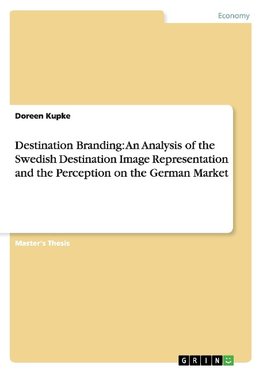
-
 Anglický jazyk
Anglický jazyk
Destination Branding: An Analysis of the Swedish Destination Image Representation and the Perception on the German Market
Autor: Doreen Kupke
Master's Thesis from the year 2013 in the subject Tourism, grade: 1,0, University of Applied Sciences Heide, language: English, abstract: Destinations are one of the tourism industries biggest brands. Nowadays, travelers
are overwhelmed with places, which...
Viac o knihe
Na objednávku
54.50 €
O knihe
Master's Thesis from the year 2013 in the subject Tourism, grade: 1,0, University of Applied Sciences Heide, language: English, abstract: Destinations are one of the tourism industries biggest brands. Nowadays, travelers
are overwhelmed with places, which fit in their holiday scheme. The tourism
market is crowded by destinations and the outcome is the substitutability of
places. (Pike, 2005) Destination branding is a way to differentiate a destination
from its existing competitors. Branding a country is a complex and multilevel
business. One of the core aspects in destination branding is to identify and differentiate
a destination through to a positive destination image. The destination
image is a crucial part in the travelers' decision making process and verifiable
influence the tourist behavior. Therefore the destination image has become one
of the major concepts in destination marketing. Special focus is given to the
destination image theory, which is a major aspect in destination branding.
(Echtner & Ritchie, 2003; Qu et al., 2011; Wang & Pizam, 2011)
Just as product brands, destination brands are living entities. They have to be
managed continuously and changed over time, to ensure a fit to environmental
changes. (Wang & Pizam, 2011) Sweden has therefore developed a national
branding and sales strategy for the tourism industry to implement until 2020 and
fully launched in 2013. (Gaßmann, 2013) A part of this strategy is the creation
of special themes to present a holistic Sweden image and destination brand.
(Communication Guide, 2013) Among others, this strategy will be used to compare
the presented and advertised Sweden image with the image perception on
the German source market, to analyze compliance or incongruity. Germany is
an interesting and important source market for the Swedish tourism industry.
According to the research of the UNWTO, Germany is one of the biggest
spenders in the tourism industry in 2011 (UNWTO, 2012). Based to the results
from IBIS, the Swedish Border Survey about foreign visitors in Sweden, Germany
hold the fourth place, after Norway, Finland and Denmark considering the
amount of travelers to the country in 2011, with 1.796.016 visitors (IBIS, 2012).
Taking this into account, presenting a positive, fitting and attractive country image
has to be one of Sweden's main aims. [...]
- Vydavateľstvo: GRIN Verlag
- Rok vydania: 2014
- Formát: Paperback
- Rozmer: 210 x 148 mm
- Jazyk: Anglický jazyk
- ISBN: 9783656677871




 Nemecký jazyk
Nemecký jazyk 






